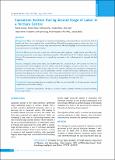Please use this identifier to cite or link to this item:
https://hdl.handle.net/20.500.14356/1673Full metadata record
| DC Field | Value | Language |
|---|---|---|
| dc.contributor.author | Gurung, Padma | - |
| dc.contributor.author | Malla, Sameer | - |
| dc.contributor.author | Lama, Sushma | - |
| dc.contributor.author | Malla, Anagha | - |
| dc.contributor.author | Singh, Alka | - |
| dc.date.accessioned | 2023-05-18T06:11:45Z | - |
| dc.date.available | 2023-05-18T06:11:45Z | - |
| dc.date.issued | 2017 | - |
| dc.identifier.citation | GurungP., MallaS., LamaS., MallaA., & SinghA. (2017). Caesarean Section During Second Stage of Labor in a Tertiary Centre. Journal of Nepal Health Research Council, 15(2), 178-181. https://doi.org/10.33314/jnhrc.v15i2.1016 | en_US |
| dc.identifier.issn | Print ISSN: 1727-5482; Online ISSN: 1999-6217 | - |
| dc.identifier.uri | http://103.69.126.140:8080/handle/20.500.14356/1673 | - |
| dc.description | Original Article | en_US |
| dc.description.abstract | Abstract Background: There is an alarming rise in caesarean section leading to increased adverse outcomes for both the mother and fetus when compared with vaginal delivery. Within this increasing caesarean section rate, there is a concerning increase in the rate of second stage caesarean section. This study highlight the feto-maternal outcome of caesarean section in second stage of labour. Methods: This was a retrospective cohort review of all women with a singleton, cephalic fetus at term delivered by caesarean section in the second stage of labor between April 1, 2013 and March 30, 2017 at Patan Academy of Health Sciences. The main outcome measures were second stage caesarean section, indications and its maternal and fetal morbidity. Results: During the study period, there were 40,860 deliveries. A total of 18,011 (44%) babies were born by caesarean section, 10484 emergency and 7527 elective. Out of the emergency caesarean section, 200 (1.9 %) were performed in second stage of labor. In this study, the most common indication was cephalopelvic disproportion. (92.4%) were delivered without a trial of instrumental delivery. In terms of maternal complications, atonic post partum haemorrhage uterine incision extension 18 (12.5%), postoperative fever 27(18.8%), wound infection 7 (4.8%) were observed. In perinatal complications, meconium stained amniotic fluid 49(34.2%), neonatal hyperbilirubinemia 14(9.7%) and increased nursery admission 2(15.3%) and 2(1.3%) perinatal mortality were seen. Conclusions: Cesarean sections done in second stage of labor are associated with several intra-operative maternal complications and neonatal morbidity. Keywords: Caesarean complications; emergency caesarean section; maternal morbidity; neonatal morbidity; second stage of labor. | en_US |
| dc.language.iso | en | en_US |
| dc.publisher | Nepal Health Research Council | en_US |
| dc.relation.ispartofseries | May-Aug, 2017;1016 | - |
| dc.subject | Caesarean complications | en_US |
| dc.subject | Emergency caesarean section | en_US |
| dc.subject | Maternal morbidity | en_US |
| dc.subject | Neonatal morbidity | en_US |
| dc.subject | Second stage of labor | en_US |
| dc.title | Caesarean Section During Second Stage of Labor in a Tertiary Centre | en_US |
| dc.type | Journal Article | en_US |
| Appears in Collections: | Vol 5 No 2 Issue 36 May-Aug 2017 | |
Files in This Item:
| File | Description | Size | Format | |
|---|---|---|---|---|
| 1016-Article Text-2334-1-10-20170908.pdf | Fulltext Download | 258.17 kB | Adobe PDF |  View/Open |
Items in DSpace are protected by copyright, with all rights reserved, unless otherwise indicated.
